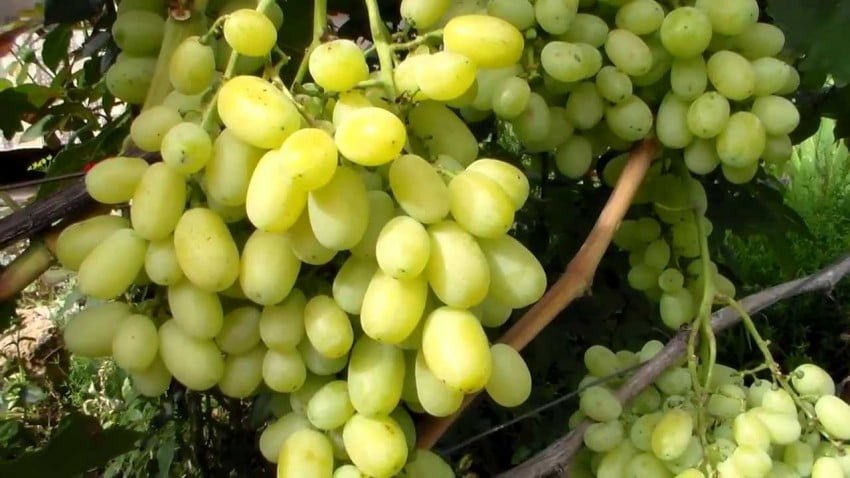In the first part of our story about the village of Costesti in Moldova, we discussed the factors of their success. It is important to remember that this village of only 12,000 people generated about $30-40 million in proceeds from the sale of grapes, plums, cherries and other fruits plus they actively participate in cooperation. The Association of Table Grape Producers and Exporters was also established Costesti, which provides great technical and marketing support to table grape growers.
In this second part, we will explain the technological trends and new technologies for growing table grapes and illustrate this in videos.
In order to reduce the risks to grapes from bad weather and damage from hail, they recently tried to cover the grapes in Costesti with a special film. This technology also improves the overall quality of the product, which means getting a higher price and reducing losses during storage. And although it costs more than $20,000 per hectare to cover the grapes, it pays off very quickly.
According to Moldovan table grape growers, without covering the vineyards in Moldova, it is unrealistic to obtain quality products. Any rain before harvest can destroy the quality of the product and make it unsuitable for long-term storage. Such grapes can only be sold for processing into grape alcohol very cheaply, which means that you will receive a guaranteed loss. Sheltering the vineyards also helps to extend the harvesting season, which is very important in the face of a shortage of labor. High labor costs and simply the physical absence of people to work in harvesting fruits and berries are one of the most acute problems in the village and indeed throughout Moldova.
Farmers in Costesti are also switching to pergola table grapes in large numbers to increase plantation productivity. A joint FAO/EBRD project has been promoting the transition to this technology for several years now, which is already yielding its first positive results. Also, many growers have installed weather stations with soil moisture sensors in order to use water more efficiently, reduce the risks of losses from bad weather and improve product quality.
In the video below, you will see what a Moldovan plantation of table grapes under film to protect them from rain and hail looks like. You can also see how a conventional plantation is being converted to pergola technology and how grapes are transported after harvest to minimize labor costs. The video includes an interview with the farmer himself about the reasons for the transition to more modern cultivation technologies.
Also in Moldova, projects are underway for growing table grapes in greenhouses, which allows for almost twice the yield and sells 4-5 times higher yet without having to invest in expensive storage facilities. These technologies are also actively promoted by the FAO/EBRD project. At the 2019 conference “Fruit and Vegetable Sector of Moldova – the Best Investment Niches”, a session was allocated to the cultivation of grapes in greenhouses.
In the second video below, you can watch a master class on cutting table grapes in a greenhouse by Gulom Otajanov, agronomist of the Khoja Negmat Farm from Tajikistan for the farmer Yuri Bivol from Moldova. Ali Sotivoldiev helps him. Farmers claim that with such pruning, 80 tons of grapes per hectare can be obtained.
Early grapes are in high demand since Moldova is situated near many Black Sea resorts where tourists in large numbers visit every July and August. Growing early grape varieties in greenhouses makes meeting this demand possible because high quality products are guaranteed. Greenhouses practically eliminate risks from frost, hail, rain and other weather factors and costs of protecting against pests and diseases are reduced.
High quality table grapes from greenhouses are very transportable, which increases its value in the eyes of buyers like supermarket chains and wholesalers. In addition, there are less problems delivering in the summer to the resort cities further away in Ukraine or Romania and even as far as Russian markets where grapes are also very relevant in July-August.
In July-August, retail prices for grapes, even on the domestic market of Moldova, reach 4-5 euros per kg. The first farmers who introduced greenhouse technologies for growing grapes have already realized they can generate 6-10 times more revenue per hectare than traditional approaches. Therefore, one should expect the rapid development of this segment of the grape business in the coming years, especially since there are funds for investment in the village of Costesti where the traditional grape business is also profitable.
In the last video below, you can see what the grapes look like in a greenhouse as well as watch an interview with a farmer about the specifics of growing greenhouse grapes. He also explains why he switched from tomatoes, cucumbers and peppers to growing table grapes indoors. The farmer grows Rochefort grapes (a relative of the Cardinal variety).
Read also:
Grape capital of Eastern Europe – Costesti, Moldova: village of multimillionaires (part 1)
Grape capital – Costesti, Moldova: storage and cooling plus veneer box production (part 3)
The use of the site materials is free if there is a direct and open for search engines hyperlink to a specific publication of the East-Fruit.com website.




